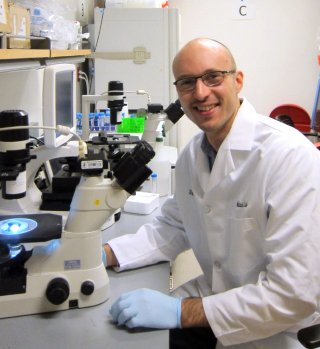Blood stem cell breakthrough could make treatments safer and more effective
A method of growing blood stem cells in the laboratory has been developed by researchers at Stanford University and the University of Tokyo, in a breakthrough that could spare some people with blood and immune disorders from the side effects of intensive chemotherapy and radiotherapy.
Growing viable blood stem cells outside of a patient’s bone marrow has eluded scientists for decades.
Using a new approach, researchers were able to increase the size of blood stem cell samples by up to 900-times in just one month.
The research, which was partly funded by Bloodwise, is published in the journal Nature.
If the technique, which has shown remarkable results in mice, is successful in humans, it could significantly increase the number of blood cancer patients able to receive a potentially life-saving stem cell transplant. It is hoped that the technique could be ready to be tested in clinical trials within five years.
What are stem cell transplants?
Stem cell transplants are used to treat blood cancers, including leukaemia, as well as immune disorders and genetic blood diseases. The treatment involves replacing patients’ blood stem cells with new, health stem cells, which either come from a donor or are previously harvested from the patients themselves.
Collecting enough blood stem cells from donors to ensure transplantation success is often difficult in the treatment of blood cancers. If the new approach can expand human blood stem cells, it could overcome this barrier. It could also open the door to the wider use of blood stem cells from other sources, including umbilical cord blood, which usually contain too few stem cells for transplantation.
Treatment with high-intensity chemotherapy or radiotherapy is also needed before a transplant in order to destroy diseased cells and the patient’s existing stem cells - to make space for donor blood stem cells in the bone marrow and create a new immune system that can kill any remaining cancer cells.
Reducing the use of intensive treatment
Doctors try to lower the use of high-intensity conditioning therapy as much as possible to reduce side effects, but they can only do so if they know that this will not allow leftover malignant cells to grow after the transplant.
Giving a stem cell transplant to patients who have not previously received intensive treatment is not normally possible, because of the large numbers of donor blood stem cells that this would require.
The researchers showed that rare blood stem cells, known as ‘haematopoietic stem cells’, could be expanded in large numbers in a laboratory before a transplant – avoiding the need for intensive ‘conditioning’ treatment in some patients.
Creating the right conditions for blood stem cells to grow
They developed a laboratory culture specially designed to encourage blood stem cell growth, using a synthetic chemical called polyvinyl alcohol, instead of a blood plasma protein culture traditionally used to grow blood stem cells, which has a high risk of contamination.
Cultures of just 50-100 blood stem cells were multiplied using the new approach over a month and transplanted into mice that had not received conditioning radiotherapy. The results were remarkable, with all mice showing donor blood stem cell engraftment and blood production.
The same process was also used to cure immunodeficient mice. Donor stem cells formed a new immune system in the mice without the need for conditioning radiotherapy.
Dr Adam Wilkinson, who led the research at the Stanford University School of Medicine, said: “These findings have important implications for the future treatment of a number of blood diseases including blood cancers. I hope that we can one day spare patients from the toxic conditioning treatments that are currently needed for stem cell transplantation. The next step of our research is to optimise this process to expand human blood stem cells”.

Dr Adam Wilkinson
Dr Alasdair Rankin, Director of Research at Bloodwise, said: “Stem cell transplants can offer the best chance of a long-term cure for some people with blood cancer, but not everyone will be able to have a transplant and many patients cannot tolerate the gruelling side-effects connected to treatment. This incredibly important research opens up the possibility that this lifeline could be available to more people in the future.”
